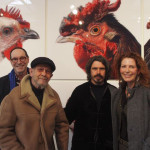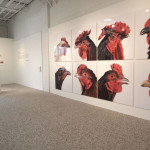INCEPTION: THE COSMOPOLITAN CHICKEN PROJECT
KOEN VANMECHELEN
FEBRUARY 1 – MARCH 9, 2013
The Cosmopolitan Chicken Project: Diversity and Dualism
Nothing is what it seems. That is but one of many – much more surprising – lessons of the Cosmopolitan Chicken Project (CCP), a worldwide cross-breeding program involving national and regional chicken breeds started in 1998 by visual artist Koen Vanmechelen (b. 1965, Sint-Truiden, Belgium).
Vanmechelen found that each successive generation of hybrids was more resilient than its purer-bred parents. The chickens lived longer, were less susceptible to disease, and exhibited less aggressive behavior. Also, less unexpectedly, the morphological and phenotypical characteristics were blurred by selective breeding. The ultimate result of many generations of cross-breeding is a truly Cosmopolitan Chicken, carrying the genes of all the world’s chicken breeds. The starting point for all these different breeds once was the Red Jungle Fowl – the original chicken. Its many descendant breeds are all man-made end-points, sometimes literally so, in the sense that they are infertile. Vanmechelen wants to end all these breeds by blending them back into a new starting point, providing a chicken-breeding example of the principle of creative destruction. But the CCP does not aim to reconstitute the proto-chicken. It does not want to return to the past. On the contrary, it symbolises the future. The CCP is the starting point of a new form of evolution that will never end, a perpetuum mobile of genetic diversification and recombination. Vanmechelen’s oeuvre is as diverse and as hybrid as the Cosmopolitan Chicken itself: it’s a unique mix of painting, drawing, photography, video, installations and wooden sculptures, whose unifying theme is the chicken and the egg. But, as mentioned before: nothing is what it seems. The core of the project is neither chicken nor egg, but crossbreeding and the diversity that comes from it.
The Cosmopolitan Chicken holds up a mirror to us. Cross-breeding is a practical but also a philosophical necessity, if not a moral duty. Today’s chicken breeds are failing; to prevent in-breeding and degeneration, new blood is needed. “Every organism needs some other organism in order to survive,” says Vanmechelen, “If there is one secret in life, maybe it’s that everything is dual. Chicken and egg, cause and effect, good and bad, construction and destruction: everything exists in relation to the Other. If you pursue this line of reasoning, you might even conclude that there’s a parallel solar system outside our own, ensuring our continued survival.”
“I see the chicken as a metaphor for man and the egg both as a metaphor for the world and as the laboratory of the future. The egg is a protected environment and a source of life. Yet it is also a cage, a restriction from which we have to break free.” History teaches us that progress is predicated on daring to let go of what we already have. The result of hybridisation is often uncertain. Do we dare expose ourselves to the unexpected? Vanmechelen certainly does: “Fertilisation, enrichment – they always come from outside. It’s precisely the unexpected things that are important to me. I take notice of apparent coincidences.” This is why the Cosmopolitan Chicken Project is also an answer in progress, a work of art that will never be complete. How the Cosmopolitan Chicken will turn out or where the program will end remain open questions, just as what will come out of the egg is an open question, every time around. The diversity that characterizes Vanmechelen’s work is not confined to the media he uses. The CCP involves a symbiosis of art, science, philosophy, politics and ethics. It is Vanmechelen’s way of reflecting on the existential questions of individual identity and life, and it touches on contemporary issues regarding globalisation, racism, genetic modification and cloning. The project invites the onlooker to join in the debate.
The Cosmopolitan Chicken Project: approach and state of progress
The first-generation hybrid, the Mechelse Bresse, resulted from cross-breeding the Belgian Mechelse Koekoek, the pride of Flemish chicken farmers, with the top French chicken, the Poulet de Bresse. Each successive generation of hybrids comes from cross-breeding the previous generation’s hybrid with another pure breed.
Meanwhile, the project brought forth 16 generations. In 2011 he presented the 15th generation, the ‘Mechelse Fayoumi’, at the Biennial of Venice. With the Poulet de Senegal, Africa was added to the project in 2012. Now, in 2013, the Slovenian Styrian will take part in the crossbreeding project.



















